Have you ever wondered how to write a song? If you’ve ever given it a try, you know how easy it is to feel overwhelmed by the whole creative process that goes into this. There are endless options for how to get started and what tools and techniques you should use to work. Because of this, it’s easy to feel paralyzed and never even get started in the first place. It’s also really easy to lose confidence and worry you won’t be able to create something that sounds good.
If any of that resonates with you, don’t worry because anyone who’s ever tried to write a song has felt one or more of those things! I’ve written and arranged 100s of songs at this point, and I still sometimes get nervous writing a new song. Recently, I decided to analyze my approach to songwriting as I’ve been writing some new songs lately. In this post I’ll be sharing my process for how to write a song so you can write your songs more efficiently and effectively. And don’t worry if you’re a beginner because I’ll be breaking everything down into an easy-to-follow format for all levels!
And just a quick disclaimer before we get started: like with almost every creative endeavor, there is no right or wrong way to write a song! The only right way to do any of this is to do whatever works best for you. I’m sharing my favorite tips and advice, but I encourage you to experiment with it for however it works best for you.
WHERE TO START
One of the best ways to start this process is to break down the main parts of a song. Breaking things down into smaller pieces is one of my favorite ways to approach anything that feels overwhelming. If you’ve ever tried to write a song or analyze one, you know there’s a lot going on all at once. The most recognizable part of a song is usually the melody, but that’s not the only piece. There’s still the chord progression, the structure, the instrumentation, the production, and the emotions and story it’s conveying. Of course, there’s more you could analyze about a song, but those are the main things we will focus on here.
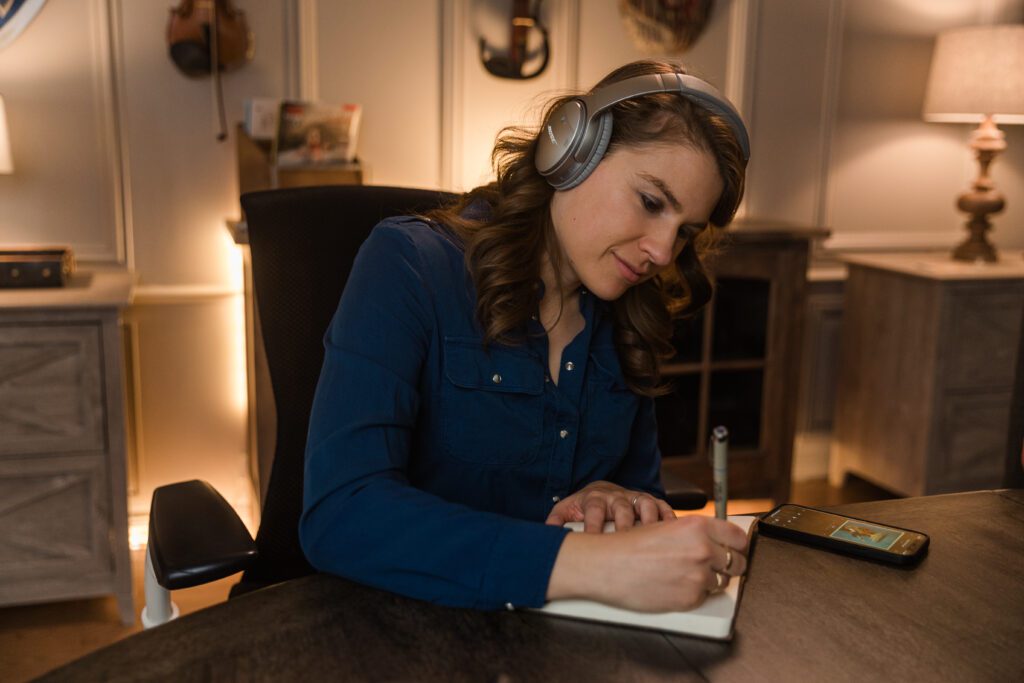

So now that we’ve broken things down, any of those main parts I just mentioned could be a great place to start your song. You can start wherever you like, but my personal favorite way to get started is to first concentrate on the emotion, vibe, or story you want to convey with your song. One of the main reasons I like to start like this is because I feel like your inner critic comes out as soon as you start trying to write a single note of music. And if what you’re writing doesn’t immediately sound fantastic (which it normally doesn’t lol), it can quickly discourage you.
HOW TO WRITE A SONG: FINDING A VIBE
Focusing on a vibe, emotion, or story helps take that inner critic out of the mix – for now. It also helps you narrow your focus on some of the musical aspects of your song before you start writing.
Just as an example, if you want to write something with happy or uplifting emotions, you’re probably going to want to write in a major key with a lot of major chords. Conversely, if you want to write something a little sad or darker sounding, it might be best to choose a minor key with more minor chords. Of course this example is just a generalization and you can absolutely use major and minor chords within the same song to convey a variety of emotions. My main point here is that you can use that emotion or vibe to help guide the musical choices behind your song.
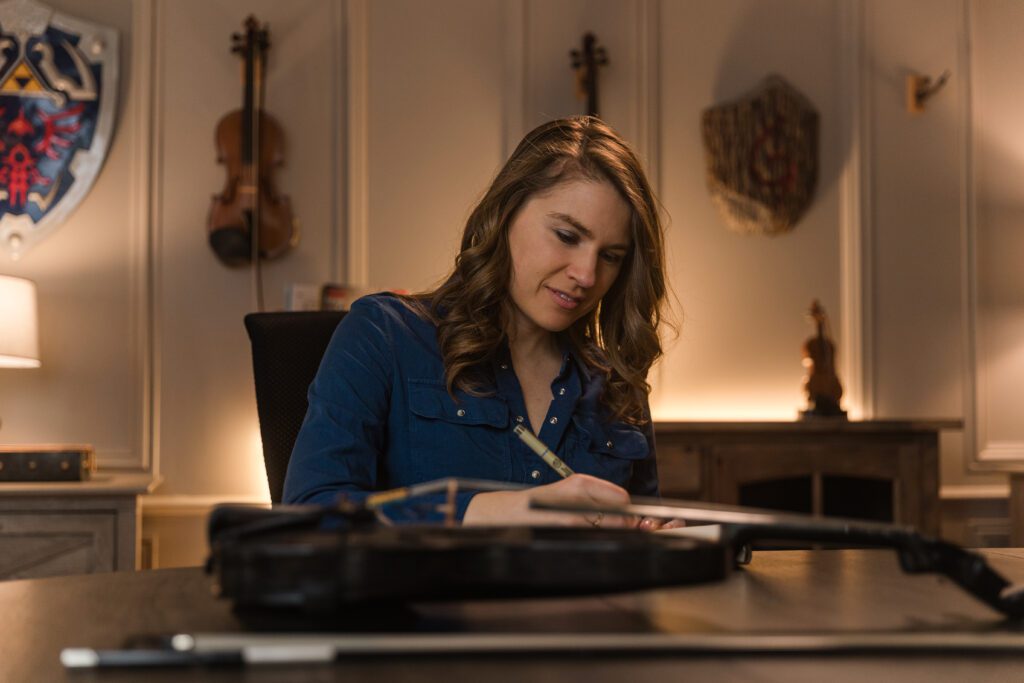

If you have a story in mind when writing your song, this is something you can do whether you write lyrics or write instrumentals. I write instrumental music, and one of my favorite songs I wrote with a story in mind is called Legendary Guardian. I had this whole video game-style boss battle story made up in my head before I started writing this song, and that story guided so many of my musical choices. Those of you who know me know that I love video games and have been inspired by video game music since I was young, so it was really fun challenging myself to create a song with that kind of a story in mind. If you want to see how I approached writing this song with that story in mind, check out my vlog where I walk you through it HERE.
LEGENDARY GUARDIAN EXAMPLE
The cool thing especially with instrumental music is that every listener might imagine something completely different when listening, but I think that’s totally fine. I just think using a story can be a great way to get started writing, especially if starting songs is something you struggle with. And I don’t always think of elaborate stories for my songs like Legendary Guardian, but I will usually always start with a general idea for a story or an emotion. It just helps me get into writing something I’m excited about much faster than if I don’t start like that. And, of course, nothing needs to be set in stone if you choose to start like this. You can always change your mind about whatever you want once you get further into the writing process!
HOW TO WRITE A SONG: TOOLS
An important next step now is to decide how you want to work and what tools you want to use. You can write everything on an instrument or work in a DAW (Digital Audio Workstation) with tons of different sounds to play with. You can use your own voice or start one way and then move to another. Again there’s no right or wrong way to do this either.
I’m a violinist, but I start writing most of my songs first on a keyboard whether I’m using an acoustic piano or writing inside my DAW with my MIDI keyboard. I’m self-taught with piano, but I usually find it’s the most comfortable and efficient way for me to write a song. My advice is to use whatever you have available that makes you feel the most comfortable and inspired. Whatever you choose at this stage, make sure you have a way to record your ideas. Whether you’re recording inside your DAW or just using your phone, it’s just so important to have those ideas to reference somewhere.
STARTING WITH MELODY OR CHORD PROGRESSION
Now it’s time to start making some music, and you also have a lot of options here! You can start with a melody, a chord progression, a beat, or a sound. You can start with lyrics, or you can start with something else. Again, it’s all about choosing whatever you feel the most inspired by. At this point, my 2 favorite ways to start writing are either with a melody or a chord progression.
HOW TO WRITE A SONG: MELODY
Some people have an easy time coming up with melodies, and others struggle more here. Melodies were a lot easier for me to write than chords were when I first started writing music because I just wasn’t used to playing a lot of chords. It’s not something that violinists do (or want to do) very often on the violin compared to an instrument like the piano or guitar. So you might find that melodies or chord progressions are easier for you to come up with depending on your musical background. Again, choose whatever works best for you, but I’m going to start out by walking you through writing melodies first.
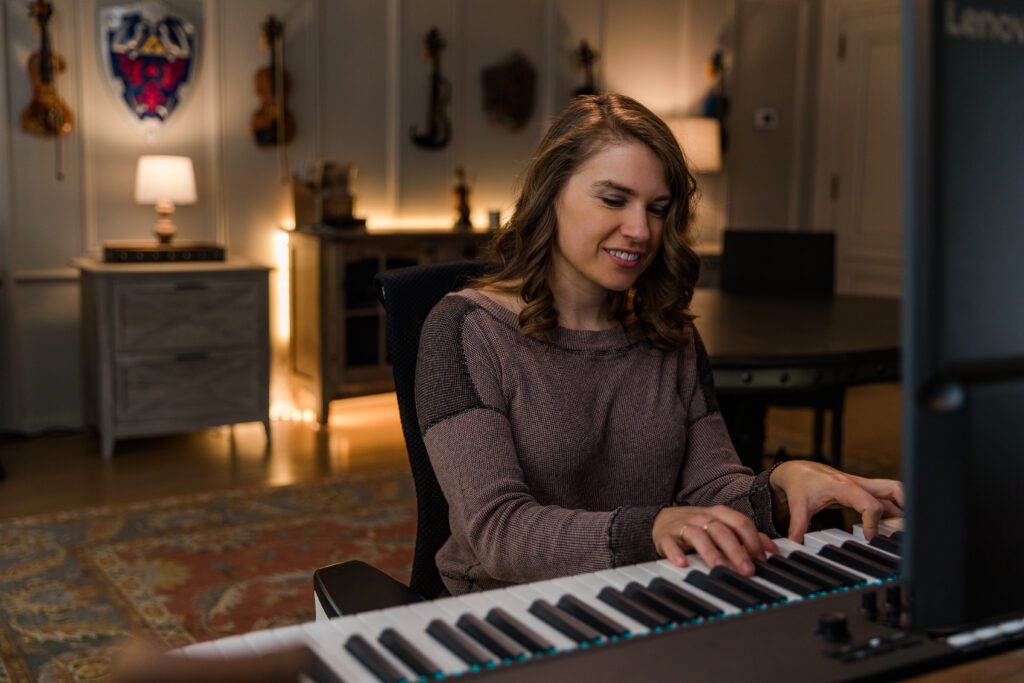

Trying to compose a melody out of thin air can be daunting, so one of my favorite things to do when writing a melody is to first start with what’s called a motif. A motif is simply a short musical idea, so essentially it’s like a little piece or building block of a melody or a theme.
One of the most famous examples of a motif is the opening from Beethoven’s Fifth Symphony. Make sure you check that out if you’re not familiar with it because it’s a really great example of a motif at work. Of course your motif doesn’t need to turn into an entire symphony like Beethoven’s, but I think it’s a lot easier to come up with a melody if you try working with a motif first. Try limiting yourself to just a few different notes and rhythms to start, and then gradually expand on the ideas you like the sound of to create a full melody.
STARTING WITH A MOTIF
I recently started one of my new songs, The Calling, with a motif and expanded on that smaller idea to create the full melody. If you want to watch me walk you through that process, click HERE to watch it in my vlog!
When you’re writing a melody, make sure you consider the overall shape and contour of the notes within your melodic line. You generally want to be moving up and down in pitch with intention vs. randomly jumping all over the place. Creating repetition in pitch, rhythm, or both is another good way to help create a more memorable melody.
MELODIES AND CHORD PROGRESSIONS GO HAND AND HAND
We’ll go through how you can start your songs with a chord progression in just a minute, but first I want to explain how your melody and chord progression generally go hand in hand in terms of what notes and chords are probably going to sound “good” together. There’s definitely some music theory behind this but I personally subscribe to the “if it sounds good, it is good” theory, meaning I let my ear and personal taste guide my choices more than anything else. And that’s the cool thing about writing music; it’s up to you to decide what you like the sound of best.
If you don’t feel you can rely on your ear as much, there’s still another way you can approach this. When you’re trying to figure out the chord progression for your melody, take a look at the notes in your melody and see if any combination of them corresponds to a specific chord. You can think of it as figuring out the missing pieces to a puzzle. For a more detailed look at this approach, make sure you check out my vlog HERE.
Just remember, there’s so much personal preference going on with all of this. Not everyone will feel the same way when listening to the same chords or progressions. But that’s where your personal taste helps guide all your choices to make something unique!
HOW TO WRITE A SONG: CHORD PROGRESSION
Now let’s talk about starting a song with a chord progression. Starting with a chord progression can be an enjoyable and inspiring way to work. I’ve written many of my songs starting with a chord progression. I’ll create an entire fully orchestrated and produced track before I know exactly what I want my melody to sound like on my violin. It’s fun to work this way because I feel a lot of inspiration from improvising over the full track. I still have plenty of creative freedom when I work like this because I’ll leave my track open from a melodic standpoint. While I’m improvising, eventually something sticks out to me as the melody I want to use. I’ll record the melody on my violin and then fill in with more harmonies and little extra production textures in my DAW after.
Remember, some songs come easier than others.
Sometimes if I’m lucky, I find a melody that I’m so excited about right away. And other times, it takes days or weeks to come up with something I like! In those cases I’ll start to get nervous and wonder if I’ll ever come up with something I like. Thankfully though if I just take a little break an idea will finally come to me. Sometimes it’s not even during the writing session; it’s when I’m cooking, playing with my kids, or right before I go to sleep. When that happens, I’ll hum whatever I hear in my head and record it with my phone. Then I know I have that idea ready for when I go into my next recording session, which is hugely helpful!
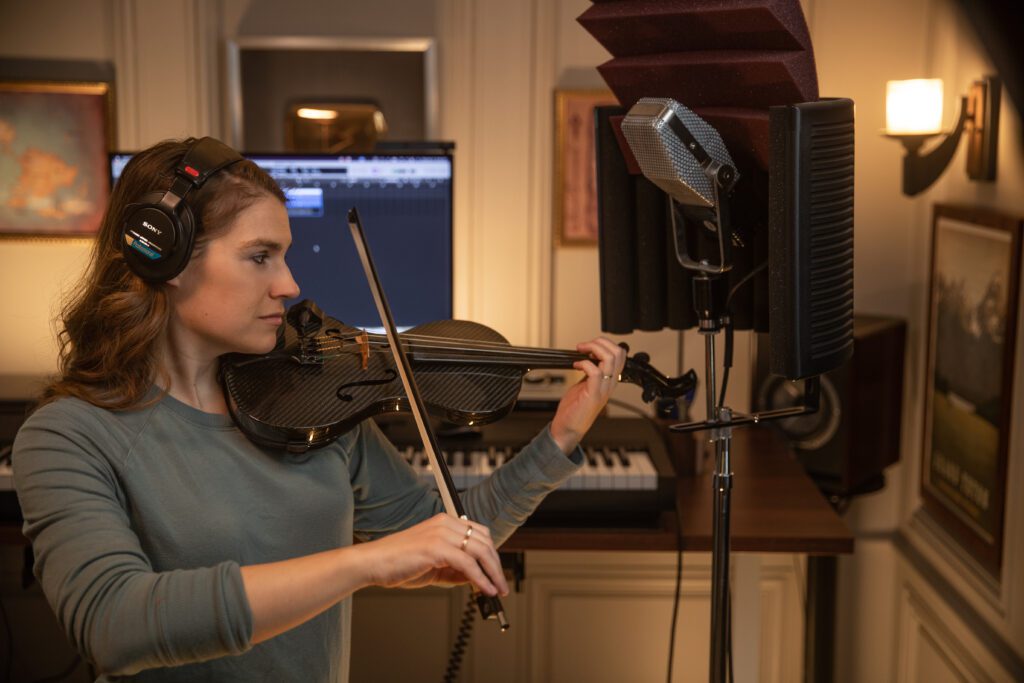

When choosing a chord progression, one of the best things you can do is analyze the songs you like and see what chord progressions are used. Certain chord progressions speak to me more than others, and I find that I use similar ones in many of my songs. Your taste will probably be different from mine though, and that’s why it’s important to discover your own favorites. Once you know what you like, try writing a song using one of those progressions.
Just because a chord progression is popular doesn’t mean you should avoid it. Some progressions are extremely popular simply because many people like the sound of them. Because of that, many of the same chord progressions have been used in thousands of songs! If you like the sound of a certain chord progression, go ahead and use it.
CHORD PROGRESSION EXAMPLE
When you start with a chord progression, you can use that same approach we walked through for writing melodies, just in reverse this time. Using that method will instantly help create some guidelines for what notes will sound “good” within the context of a certain chord. I walk through this approach in detail in my vlog HERE.
Again, there are so many possibilities here with everything. I just wanted to give you some tips to simplify this process to help you get started. Hopefully you can see how your chord progressions can help create some guidelines to help you achieve the sound you’re looking for.
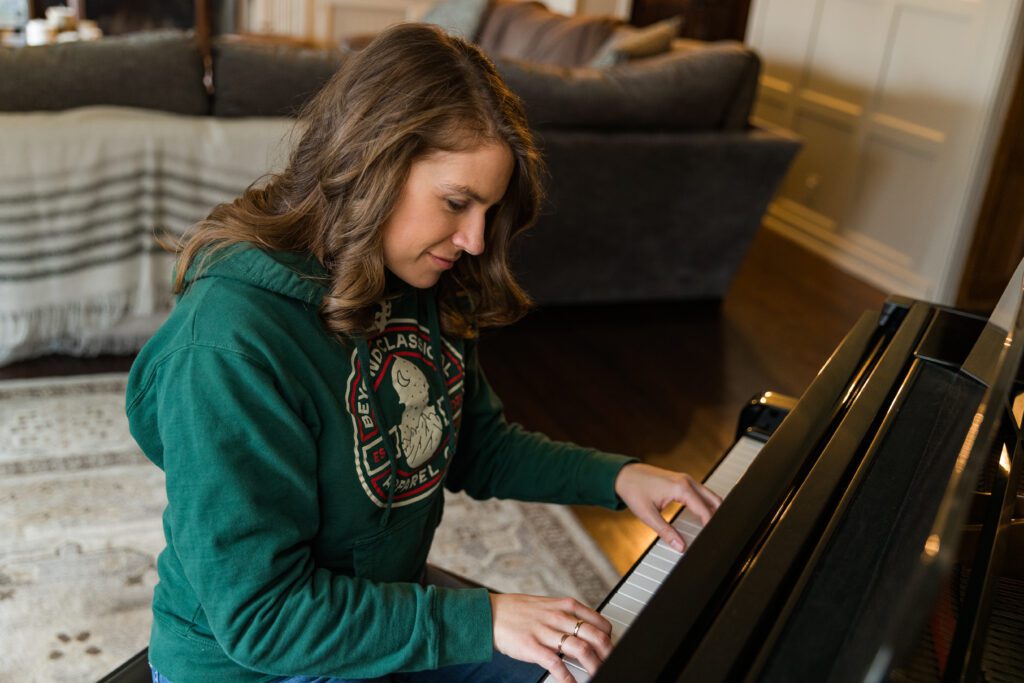

Quick side note: I want to give a shout-out to the key of C Major because I think it’s such an excellent key for beginners to know. It doesn’t contain any sharps or flats so you only need to worry about playing the white keys on the keyboard. When I first started writing songs, I would start most of my songs in the key of C Major because it was the easiest for me to play and understand. I could then later transpose the entire song into a different key from within my DAW if I wanted. My point here is that it’s ok to get started without knowing how to play every single key and chord. Pick one key to learn well that feels easy for you to write in, and then learn new ones as you gain more experience.
HOW TO WRITE A SONG: STRUCTURE
Alright, the next thing I want to discuss here is song structure. This is how you organize the different sections of your song together. For example, one of the most popular song structures used in modern pop music is:
Verse
Pre-Chorus
Chorus
Verse 2
Pre-Chorus
Chorus
Bridge
Chorus
You’ll also sometimes hear this with an Intro and Outro added to the ends. Just as a popular example, Ed Sheeran’s song “Shape of You” follows this structure.
Another simpler version of that structure is:
Verse
Chorus
Verse 2
Chorus
Bridge
Chorus
also known as ABABCB, where A corresponds to the verse, B corresponds to the chorus, and C corresponds to the bridge.
Plenty of popular songs have also been written only using a Verse and Chorus, just alternating between the two. This might look something like ABABAB. There’s also simply an AAA song structure where one main verse or theme repeats the entire time.
“Time” by Hans Zimmer from the movie Inception is an example of the AAA structure. The entire song keeps repeating the same melody and chord progression. But it keeps evolving in terms of the complexity of the harmonies, counter melodies, and production. That way it never feels boring or too repetitive, it just sounds fantastic in my opinion.
Those are just some examples of popular and familiar song structures. If you’re just starting out with songwriting, I’d recommend trying one of those out.
They’re popular for a reason and they’re already very familiar to your average listener. Unless you really want to, there’s no reason you should feel pressured to make up an entirely new song structure. Just like we talked about with chord progressions, using one you’ve heard before in another song is perfectly fine.
MY SONG STRUCTURE
If you feel like a song you’re writing doesn’t fit into one of these structures, it’s also okay to make up a structure. My song that I walked you through earlier, Legendary Guardian, is structurally all over the place. There are three separate main themes, some sections include a pre-chorus type element, some include a chorus, some don’t. It wouldn’t fall into any of the popular structures I just mentioned, but that’s okay because that’s what I felt like worked best for that particular song. Depending on the style of music you’re writing, you might always write songs in the same structure or change the structure from song to song; it’s totally your call.
Many of my songs usually follow one of these popular structures though. I also find that I’m typically able to finish a song much faster once I’ve settled on a structure. I have a much better overview of what sections I’ve already done and what sections I still need to fill in that way. Usually, I like to start writing the verse or the chorus for my songs first, but sometimes I’ll start right at the very beginning with an intro. Other times I work chronologically starting with an intro, then verse, etc. Other times I’ll write the chorus first, then a bridge, then an intro. It just really depends and changes from song to song.
HOW TO WRITE A SONG: LYRICS
One thing we haven’t touched on here much yet are lyrics. I write instrumental music, so while I’ve tried writing lyrics in the past for fun, it’s not a topic that I have as much personal experience with.
For those of you who plan to write songs with lyrics, I’ll sum up that part of the process here. I explained earlier how I like to use music to convey emotions or tell a story. If you’re writing a song with lyrics, you can use words to tell the listener exactly what you want them to know or feel. Many popular songs use lyrics to connect with their listeners through writing about experiences and emotions that are relatable.
You might like to write lyrics that are very literal and very obviously tell your listener exactly what’s happening in your song. Or you might want to write things in a more ambiguous way that leaves things up to interpretation.
You might feel comfortable sharing your personal experiences and emotions. But if you are less comfortable with that, you can write as if you were a character in a story. That way, you can still write about experiences and emotions that are personal to you without feeling like you’re revealing too much.
If you struggle with finding the right words to get started, try writing down thoughts, words, or phrases that inspire you. When you’re ready to start writing, you’ll have this whole notebook of ideas to be explored. I’ve heard a lot of great lyricists mention that reading poetry is incredibly inspiring to them. Analyzing the lyrics from your favorite songs can also help you learn about your preferences when it comes to lyrics.
FREE LYRIC RESOURCES
There are also a couple of free tools that can help with writing lyrics, one simply being thesaurus.com. That is a great way to come up with different words that are more interesting or colorful to express yourself. If you’re ever struggling to find the right word to rhyme with one of your lyrics, the website Rhyme Zone is an excellent resource also.
AUDIO AND RECORDING COURSE
After you’ve written your song, the next step is to record it! If you’re looking to dive deeper into the world of home recording, I offer an online course called Audio Recording & Production Essentials. In it, you’ll learn how to record professional-sounding music from your own home.
It’s really great for beginners because I show you what gear you need and how to use it. I show you exactly how I record and edit my violin recordings. We walk through all the basics of mixing and mastering. I also walk you through the entire production and recording process for one of my popular cover songs from initial concept to finished song. And if you found this blog helpful, I cover even more details about my creative and technical process for writing original music and arranging cover songs inside the course.
I’ve had almost 1,000 people take it, so I hope you check it out if you’re interested in recording and producing your own music! You can find more info on the course here.
I hope this blog helped you on your songwriting journey. Thanks so much for reading and I’ll see you again soon!
All of my courses can be found here.
If you are more of a visual learner and would like to watch my whole vlog, here is the link for that!
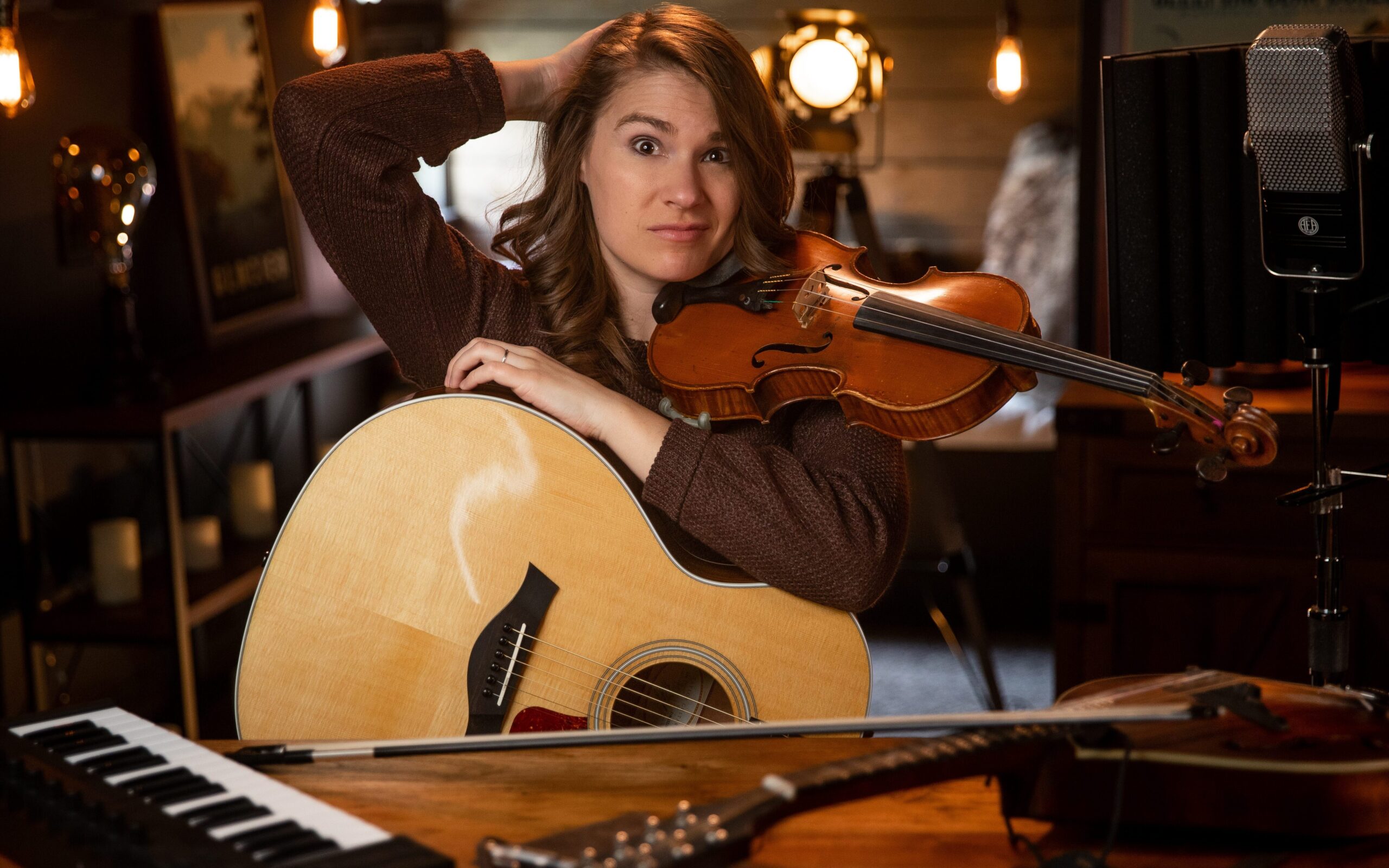

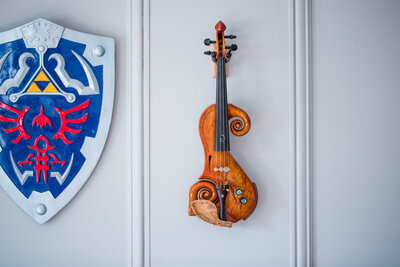
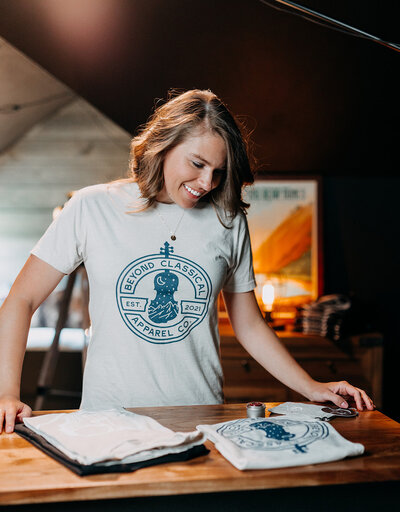
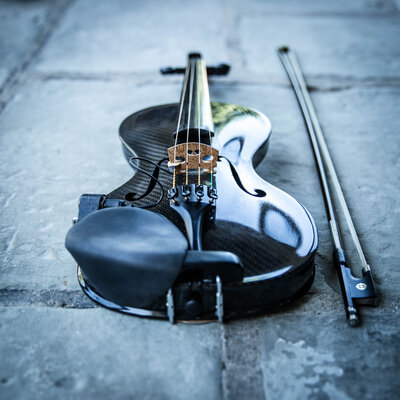
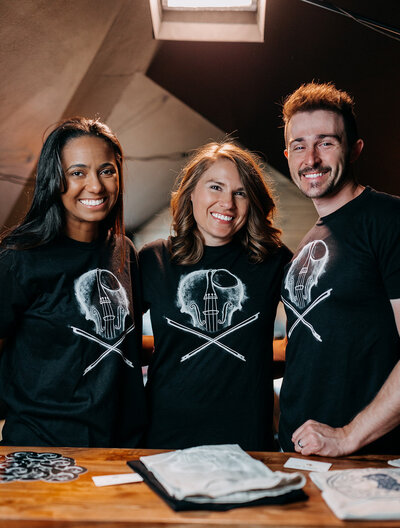


+ show Comments
- Hide Comments
add a comment